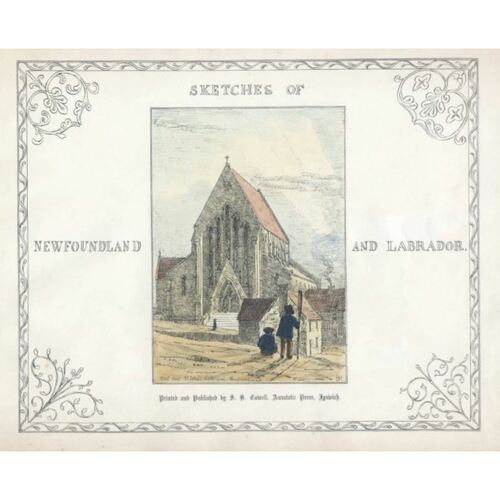
Source: Link
GREY, WILLIAM, Church of England clergyman, missionary, educator, architect, and artist; b. 27 Oct. 1819 in England, second son of the Reverend Harry Grey and Frances Elizabeth Ellis; m., on 25 July 1849, Harriet White by whom he had one son, William, 9th Earl of Stamford; died 1 Sept. 1872 in Exeter, England.
William Grey graduated in classics with a ba in 1842 and an ma in 1845 from Magdalen Hall, Oxford, where he also studied church architecture and ecclesiology. Having been ordained by the bishop of Salisbury, in 1843 Grey became curate of Allington and Amesbury, Wiltshire, where he surprised his neighbours and shocked his relatives by lodging with an old farmer. “His quarters did for him, for he was content with the smallest attendance and the simplest fare,” observed a neighbour.
Late in 1848 Edward Feild, bishop of Newfoundland, who considered Grey to be “a very valuable acquisition” with “qualities eminently serviceable to St John’s,” engaged him to serve as his secretary and chaplain on a visitation of Bermuda and Newfoundland. Heir presumptive to the earldom of Stamford for the greater part of his life, Grey, unlike most of the men who became missionaries, was in no need of preferment or social advancement. Together with a few others, he is an example of the exceptional type of missionary whom Feild inspired to serve in Newfoundland.
In 1849 Grey’s offer to begin a mission on the Labrador coast was refused by Bishop Feild who felt that Grey’s talents were more needed in St John’s. Feild instead appointed Grey as the principal of Queen’s College, St John’s – the remodelled version of the theological institute founded by Bishop Aubrey George Spencer in 1841. There students were hardened for work in Newfoundland by a semi-monastic discipline, were taught theology, and, since the college was Tractarian in tone, could make their confessions to the principal.
After a year as principal, Grey, probably because he wanted a more distinctly missionary existence, moved to Portugal Cove, near St John’s. In 1849 he had become diocesan architect, and, as well as designing numerous new churches, such as St Peter’s, Portugal Cove, he spread the principles of the Gothic Revival by regular lectures to students and clergy. As colonial correspondent of the Oxford Architectural Society, he contributed an article on “The ecclesiology of Newfoundland” to the Ecclesiologist. In it he bemoaned the lack of good church architecture in Newfoundland, and praised Feild’s campaign against high pews and galleries.
His wife being ill, Grey left for England in 1853 but returned to Newfoundland in 1857 to accompany Feild on a voyage of visitation of Newfoundland and Labrador. During the voyage, he designed churches at Battle Harbour and Tilt Cove, and, feeling that the quality of sketches published by the Society for the Propagation of the Gospel was too low and that Newfoundland, a “country little known and often very under-rated,” deserved better publicity, he made sketches of the colony’s churches and scenery which he published in England.
On his return to England late in 1857 or early in 1858 he took charge of the parish of Milford, Whitley, from which he retired in 1865 to live in Exeter. He was in poor health but occupied himself by decorating the roof of St Mary-Steps, a project which may have expedited the throat cancer which caused his death.
William Grey brought to Newfoundland the ideas of the Gothic Revival, and by his sketches and writings helped his bishop to publicize in England the Church of England in Newfoundland.
USPG, C/CAN/NFL, 7; D, 9A, 9B. William Grey, “The ecclesiology of Newfoundland,” Ecclesiologist (London), XIV (new ser., XI; 1853), 151–61; [], Sketches of Newfoundland and Labrador (Ipswich, Eng., [1858]). Burke’s peerage (1967), 2357. Thomas Mozley, Reminiscences, chiefly of towns, villages and schools (2v., London, 1885), II.
Cite This Article
Frederick Jones, “GREY, WILLIAM,” in Dictionary of Canadian Biography, vol. 10, University of Toronto/Université Laval, 2003–, accessed April 14, 2025, https://www.biographi.ca/en/bio/grey_william_10E.html.
The citation above shows the format for footnotes and endnotes according to the Chicago manual of style (16th edition). Information to be used in other citation formats:
| Permalink: | https://www.biographi.ca/en/bio/grey_william_10E.html |
| Author of Article: | Frederick Jones |
| Title of Article: | GREY, WILLIAM |
| Publication Name: | Dictionary of Canadian Biography, vol. 10 |
| Publisher: | University of Toronto/Université Laval |
| Year of revision: | 1972 |
| Access Date: | April 14, 2025 |



